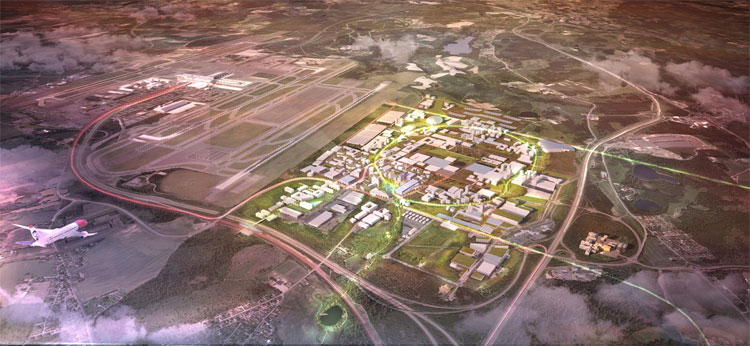Norway built the first city in the world using only clean energy
Two architectural firms, Haptic and Nordic (Norway), have announced the Oslo Airport City (OAC) city construction plan, located right next to Oslo airport and the first city in the world to fully utilize energy. clean amount.
According to Tomas Stokke, director of Haptic: 'This is a unique opportunity to design a new city from the beginning'.
By design, OAC will be located on 260 acres (104 hectares) of land with a construction floor area of nearly 1 million square meters, becoming a residence of 35,000 people and carrying features of a sustainable city.
 Airport city of OAC.(Photo: Futurism).
Airport city of OAC.(Photo: Futurism).
- The city will have plenty of walking space for residents or visitors to make more choices when traveling, not necessarily using motor vehicles.
- The OAC center has absolutely no vehicles. This option can only be feasible by building a lot of walking space.
- The city will deploy a variety of green technologies, including self-driving cars, automatic lights, intelligent waste disposal systems.
- OAC will only use the renewable energy produced by the city to help reduce fossil fuel consumption, along with the costs of transport.
- The city will sell surplus energy to other places. In addition, this energy can also be used to melt ice on aircraft when the weather is too cold, helping to reduce fuel use at airports.
- Inside the OAC, only electric cars are circulated.
- The city will have a friendly, close public transportation system, including dedicated bicycle routes, and a variety of outdoor activities, without electricity.
Although the location chosen to build a sustainable city sounds random, it is actually well suited to a plan for an almost utopian place. It is estimated that the number of employees at Oslo airport will double by 2050. Thus, OAC can become a perfect residence for employees and their families, besides millions. transit visitors.
According to Thor Thoeneie, OAC project executive director: 'We fully believe in the future of the city, the problem is only time'.
Construction activity is expected to begin in 2019, and the city will be completed in 2022. This plan sounds ambitious and in fact, the schedule may change. However, for Norway's commitment to sustainable development, it is not too far away and will soon become a reality.
- Turn garbage into clean energy
- Successful development of clean energy
- Attend the cleanest cities in the world
- The world needs to accelerate the application of clean energy
- Energy Observer - 'Laboratory' of floating energy throughout the world
- Norway prepares to produce clean electricity from salt
- Vietnam won the Global Energy Award
- Kjørbo - the world's most environmentally friendly building in Norway
- America built the world's tallest solar power tower
- Super clean city in Denmark
- China is at the forefront of clean energy use
- Renewable energy is enough to provide 1/4 of the world's electricity demand
 'Fine laughs' - Scary and painful torture in ancient times
'Fine laughs' - Scary and painful torture in ancient times The sequence of numbers 142857 of the Egyptian pyramids is known as the strangest number in the world - Why?
The sequence of numbers 142857 of the Egyptian pyramids is known as the strangest number in the world - Why? History of the iron
History of the iron What is alum?
What is alum?